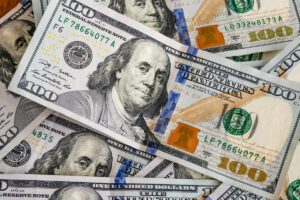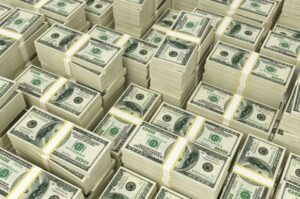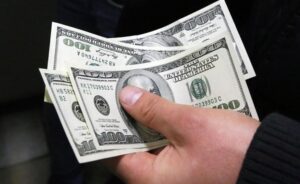
ING analysts forecast US dollar and euro parity throughout most of 2023.
“The main conclusion we drew in our currency forecast for 2023 was that a repeat of the dollar’s dominant trend next year is unlikely,” according to the review.
As noted by analysts, everyone in the foreign exchange market is concerned about whether the dollar has peaked. Data on some weakening of inflation in the U.S. and hints at easing the “zero tolerance” policy on COVID-19 in China have combined to cause the U.S. national currency has fallen by about 8% from the highs of the end.
Those in favor of continuing the dollar’s decline are fully focused on the Fed’s actions and its reversal before a full-blown cycle of monetary policy easing.
“We certainly agree that a dovish reversal at the Fed – which will eventually lead to the start of a decline in short-term government bond yields – is a necessary condition for the dollar to fall,” the survey says.
However, it also requires that investments in Europe and Asia become attractive enough to take money out of dollar deposits, experts believe.
“It remains questionable whether any of these conditions will be met in 2023, and we remain skeptical that the euro/dollar pair can maintain gains above the 1.05 level,” the report said.

The U.S. dollar is moderately rising against the euro and Japanese yen in Tuesday’s trading, while the Australian dollar is rising on the outcome of the country’s central bank meeting.
The euro is trading at $1.0487 as of 7:50 a.m. Tuesday, up from $1.0493 at the close of the previous session.
The dollar traded up to 136.97 yen against the Japanese currency, compared to 136.79 yen at the close of the previous session.
The ICE index showing the trend of the dollar against six currencies (euro, Swiss franc, yen, Canadian dollar, British pound and Swedish krone) added 0.08%.
The pound fell to $1.2189 from $1.2192 at the close of trading on Monday.
The U.S. data published the day before, which bolstered the dollar, reinforced fears that the U.S. Federal Reserve (Fed) will need to raise interest rates for a longer period than expected, writes Trading Economics.
The U.S. Services Business Activity Index unexpectedly rose to 56.5 points in November from 54.4 points a month earlier, data from the U.S. Institute for Supply Management showed. The average forecast of analysts polled by Trading Economics had expected the index to fall to 53.3 points last month. A reading above 50 points showed an increase in business activity in the service sector, while a lower reading showed it was weakening.
The Australian dollar traded at $0.6727 on Tuesday, up from $0.6699 at the close of the previous session.
The Reserve Bank of Australia (RBA) on Tuesday raised its key interest rate by 25 basis points (bps) to 3.1 percent a year at the end of its final meeting of the year. This coincided with the forecast of most analysts, reports Trading Economics.
The Central Bank has raised the rate for the eighth time in a row. Thus, the cost of borrowing rose to its highest level since November 2012. At the same time, the RBA management signaled a further rate hike to curb inflation, which remains at a high level.
The euro traded at $1.0487 as of 7:50 a.m. Tuesday, up from $1.0493 at the close of the previous session.
The dollar traded up to 136.97 yen against the Japanese currency, up from 136.79 yen at the close of the previous session.
The ICE index showing the trend of the dollar against six currencies (euro, Swiss franc, yen, Canadian dollar, British pound and Swedish krone) is showing 0.08% growth, while the broader WSJ Dollar Index added 0.06%.
The pound fell to $1.2189 from $1.2192 at the close of trading on Monday.
The U.S. data published the day before, which bolstered the dollar, reinforced fears that the U.S. Federal Reserve (Fed) will need to raise interest rates for a longer period than expected, writes Trading Economics.
The U.S. Services Business Activity Index unexpectedly rose to 56.5 points in November from 54.4 points a month earlier, data from the U.S. Institute for Supply Management showed. The average forecast of analysts polled by Trading Economics had expected the index to fall to 53.3 points last month. A reading above 50 points showed an increase in business activity in the service sector, while a lower reading showed it was weakening.
The Australian dollar traded at $0.6727 on Tuesday, up from $0.6699 at the close of the previous session.
The Reserve Bank of Australia (RBA) on Tuesday raised its key interest rate by 25 basis points (bps) to 3.1 percent a year at the end of its final meeting of the year. This coincided with the forecast of most analysts, reports Trading Economics.
The Central Bank has raised the rate for the eighth time in a row. Thus, the cost of borrowing rose to its highest level since November 2012. At the same time, the RBA management signaled a further rate hike to curb inflation, which remains at a high level.

The U.S. dollar is stable against the euro in trading on Friday, getting stronger against the pound and cheaper against the yen.
Traders will focus on the U.S. labor market report for November, which will be released at 3:30 p.m. Ksk.
The consensus forecast of experts polled by Trading Economics expects the number of jobs in the U.S. economy to increase by 200,000 in November and unemployment to remain at 3.7%.
The November labor market report is important to the Federal Reserve (Fed), which will hold its next meeting on December 13-14. Judging by futures quotations for the prime rate, the market expects the Fed to raise it by 50 bps. – to 4.25-4.5% per annum.
A new dot plot of forecasts will also be published at the end of the December meeting, reflecting the individual expectations of the members of the Federal Reserve Board of Governors and the heads of the Federal Reserve Banks with regard to interest rates.
Earlier this week, U.S. Central Bank Chairman Jerome Powell confirmed that the Fed could slow its rate hike as early as December.
Fed Vice Chairman of Banking Supervision Michael Barr on Thursday also argued in favor of a slower rate hike.
“We’ve been moving very, very quickly toward a rate level that would limit economic activity, and now that we’re very close to it, I think it makes sense to slow the pace of the hike,” Market Watch quoted Barr as saying.
The euro/dollar pair was trading at $1.0529 as of 8:20 a.m. Ksk Friday, up from $1.0527 at the close of the previous session. The pound fell to $1.2239, compared to $1.2256 at the close of trading on Thursday.
The dollar-yen exchange rate declined to 135.08 yen in trading, compared to 135.34 yen at the close of the previous session.
The ICE-calculated index showing the dollar’s dynamics against six currencies (euro, Swiss franc, yen, Canadian dollar, pound sterling and the Swedish krona) lost 0.01% on Friday, while the broader WSJ Dollar Index lost 0.04%.

The U.S. dollar is strengthening against the euro and the pound sterling in trading on Monday, becoming cheaper in pair with the yen.
The yuan exchange rate is declining amid the ongoing protests in China against covid restrictions.
The situation in China led to a decrease in appetite for risk in world markets that supports the dollar and yen, which are considered as “safe haven” currencies.
According to Bloomberg, protests were held in cities across the country, including the capital Beijing, as well as Shanghai, Xinjiang and Wuhan, which was originally the epicenter of the spread of COVID-19.
The ICE-calculated index showing the dynamics of the dollar against six currencies (euro, Swiss franc, yen, Canadian dollar, pound sterling and Swedish krona) added 0.39% on Monday, while the broader WSJ Dollar Index gained 0.25%.
The euro/dollar pair is trading at $1.0354 as of 7:55 a.m. Ksk, up from $1.0400 at the close of the previous session. The pound fell to $1.2050, compared to $1.2094 at Friday’s close.
The dollar fell to 138.44 yen against 139.19 yen at the close of the previous session. The euro slid down to 143.28 yen from 144.75 yen.
The U.S. currency pair with the yuan rose to 7.2053 yuan against 7.1654 yuan on Friday. The value of the dollar against the offshore yuan (traded in Hong Kong) rose to 7.2249 yuan from 7.1920 yuan.

The U.S. dollar is stable against the euro and the yen in trading on Friday, strengthening against the pound sterling.
A day earlier, the dollar fell in price against the world’s major currencies after the publication of the minutes of the Federal Reserve (Fed) meeting in November, which showed that the overwhelming majority of the U.S. central bank sees the need to slow the pace of rate hikes in the near future.
The ICE index showing the dollar’s performance against six currencies (euro, Swiss franc, yen, Canadian dollar, pound sterling and Swedish krone) lost 0.17% on Friday, while the broader WSJ Dollar Index was steady.
The euro/dollar pair is trading at $1.0411 as of 8:10 a.m., up from $1.0413 at the close of the previous session.
The dollar is trading at 138.66 yen against 138.64 yen the day before. The pound fell to $1.2099 from $1.2117.
On Thursday, the dollar fell 0.2% against the euro, 0.7% against the yen and 0.5% against the pound.
“Some of the Fed leaders observed that monetary policy had reached a state in which it was sufficiently restrictive to meet FOMC goals and it would be appropriate to slow rate hikes. The vast majority of meeting participants felt that a slowdown in the pace of the hike would probably be appropriate soon,” the minutes of the Nov. 1-2 Fed meeting noted.
Some of the U.S. central bank leaders, meanwhile, believed that the Fed would have to raise the rate higher than previously planned in order to meet its goal of easing inflation.
They indicated that the rate “will have to reach a somewhat higher level than previously expected,” given the lack of sufficient signals of easing inflation in the U.S. at the moment, as well as the continuing imbalance of supply and demand in the economy.

The U.S. dollar is getting cheaper against the euro, is stable against the British pound and rises against the Japanese yen in trading on Wednesday morning.
The ICE-calculated index showing the dollar’s dynamics against six currencies (euro, Swiss franc, yen, Canadian dollar, pound sterling and Swedish krona) is losing 0.13%, while the broader WSJ Dollar is down 0.03%.
The focus for traders this week is the minutes of the Federal Reserve’s November 1-2 meeting, at which the U.S. central bank raised its benchmark interest rate by 75 basis points (bps) and hinted at the possibility of a slowdown in its rate hike.
The minutes of the meeting will be published on Wednesday at 9 p.m. The experts expect the report to show that the Fed’s leaders reached a consensus on the need to slow the rate hike, Bloomberg wrote. However, there’s no consensus among them as to what interest rate cap will start to slow economic activity and lower the rate of inflation.
The euro/dollar pair is trading at $1.0329 as of 8:30 Moscow time, down from $1.0306 at the close of the previous session.
The dollar rose to 141.34 yen in trading against 141.22 yen on Tuesday.
The pound exchange rate was stable at the level of $1.1887 at the close of the previous session.
Meanwhile, the Chinese yuan was falling 0.19% against the dollar to settle at 7.1541 yuan per $1 as of 8:40 Moscow time. Investors are worried about new lockdowns in major Chinese cities because of a new outbreak of the coronavirus in the country which may trigger a slowdown in economic growth.